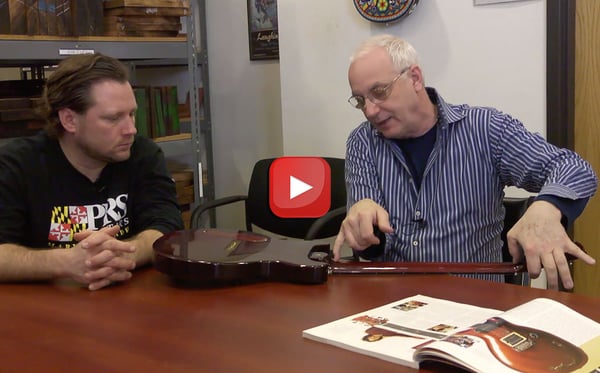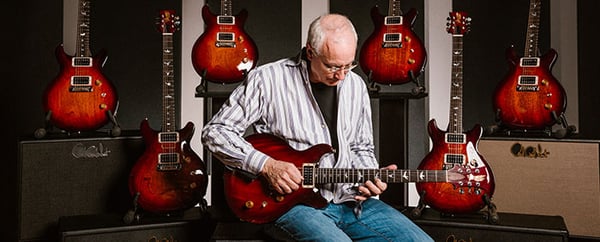 A limited edition replica of Paul Reed Smith’s 1976 “Frampton Guitar”created through a collaboration of Moore Guitars and PRS.
A limited edition replica of Paul Reed Smith’s 1976 “Frampton Guitar”created through a collaboration of Moore Guitars and PRS.
Since building his first guitar in 1972, Paul Reed Smith has always had his sights set on perfection. I think I can safely say that in the world of production guitars, PRS sets itself apart in approaching perfection in aesthetics, playability and sound. However, in pursuit of that perfection, incredible guitars created along the way can sometimes be forgotten. A great example of this is Paul’s 1976 “Frampton Guitar”, the second guitar ever built at his West Street workshop.
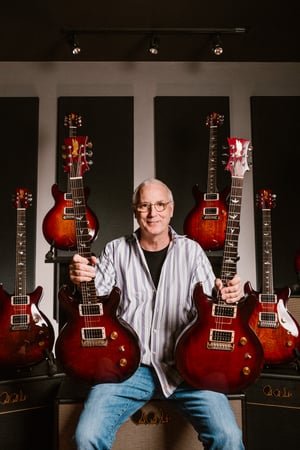 This guitar was Paul’s first commissioned build, and the guitarist ordering it was none other than Peter Frampton. Paul stated that this was the first of his builds that he felt played and sounded better than the 1953 Les Paul he used as comparison to his early attempts. Before delivering the guitar to Frampton, Paul managed to get backstage at a Return to Forever concert to show it to Al DiMeola, who immediately ordered a guitar of his own.
This guitar was Paul’s first commissioned build, and the guitarist ordering it was none other than Peter Frampton. Paul stated that this was the first of his builds that he felt played and sounded better than the 1953 Les Paul he used as comparison to his early attempts. Before delivering the guitar to Frampton, Paul managed to get backstage at a Return to Forever concert to show it to Al DiMeola, who immediately ordered a guitar of his own.
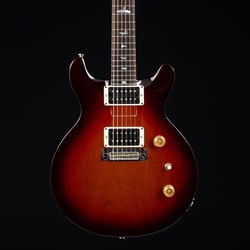 wanted to ensure that this historic instrument would not be forgotten. Brett approached Paul Reed Smith in early 2017 with the idea of recreating this guitar in a limited Private Stock run. Paul was honored by the request, but had initial reservations about releasing a guitar that he felt had been improved upon in so many ways over the years. Mulzer was able to convince Smith that the guitar’s impact on the music world made it worthy of such an effort, and the two immediately began collaborating on the details of the build. In order to be as precise as possible in recreating this instrument, the first order of business was to locate six ‘76 vintage Leo Quan Badass wraparound bridges in pristine condition. Not an easy task. Between Brett and the Private Stock team, they were able to find them, but to meet Paul’s quality standards, all had to have the saddles re-machined.
wanted to ensure that this historic instrument would not be forgotten. Brett approached Paul Reed Smith in early 2017 with the idea of recreating this guitar in a limited Private Stock run. Paul was honored by the request, but had initial reservations about releasing a guitar that he felt had been improved upon in so many ways over the years. Mulzer was able to convince Smith that the guitar’s impact on the music world made it worthy of such an effort, and the two immediately began collaborating on the details of the build. In order to be as precise as possible in recreating this instrument, the first order of business was to locate six ‘76 vintage Leo Quan Badass wraparound bridges in pristine condition. Not an easy task. Between Brett and the Private Stock team, they were able to find them, but to meet Paul’s quality standards, all had to have the saddles re-machined.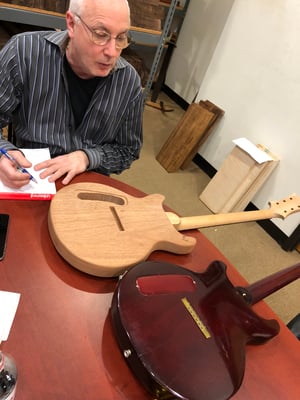 The hand-carved neck of the original Frampton was precisely measured in every dimension from nut to heel to ensure an exact duplication. Having played the original myself and thinking it may have been the most comfortable carve I ever held, I can say the First Birds make me think the same thing. They nailed the neck carve. The headstock duplicates the original Eagle that Paul drew by hand from a pattern copied from a t-shirt. The original inlay was made from mother-of-pearl piano keys that Paul had collected, and the headstock inlay was so large, it took two piano keys to make. The First Birds even get that 2-piece inlay detail correct. Original Schaller tuners finish off the top end.
The hand-carved neck of the original Frampton was precisely measured in every dimension from nut to heel to ensure an exact duplication. Having played the original myself and thinking it may have been the most comfortable carve I ever held, I can say the First Birds make me think the same thing. They nailed the neck carve. The headstock duplicates the original Eagle that Paul drew by hand from a pattern copied from a t-shirt. The original inlay was made from mother-of-pearl piano keys that Paul had collected, and the headstock inlay was so large, it took two piano keys to make. The First Birds even get that 2-piece inlay detail correct. Original Schaller tuners finish off the top end.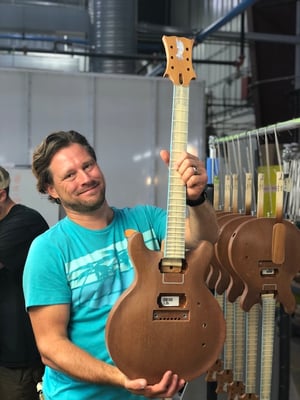 The neck and body woods are South American Mahogany, with a deep neck joint that extends beyond the neck pickup. Paul wanted extra stability for this neck that joins the body at the 23rd fret. A small block of Mahogany adorned with mother-of-pearl purfling covers the joint on the front of the guitar.
The neck and body woods are South American Mahogany, with a deep neck joint that extends beyond the neck pickup. Paul wanted extra stability for this neck that joins the body at the 23rd fret. A small block of Mahogany adorned with mother-of-pearl purfling covers the joint on the front of the guitar.iconic. You can hear the wood in each note. Think of classic mahogany instruments of the past, like Leslie West’s LP Junior, Hendrix’ Flying V, Zappa’s SG. That’s the territory we’re in here.



